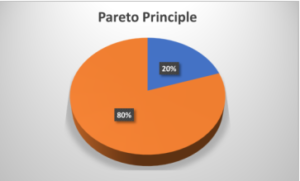The Pareto Principle, illustrated above, highlights the 80/20 rule, which suggests that 20% of efforts often result in 80% of outcomes. In business communication education, this principle can guide educators in focusing on the most impactful activities to enhance learning outcomes and streamline their teaching strategies. By refining curriculum design, instructors can better engage students and maximize the efficiency of their educational efforts.
The Pareto Principle, or the 80/20 rule, offers a valuable framework for optimizing business communication education. By focusing on the 20% of actions that yield 80% of results, educators can streamline their curriculum, enhance student engagement, and ultimately improve learning outcomes. This refined approach builds upon the original article, addressing its limitations and incorporating specific examples to provide a more actionable guide for educators.
1. Identifying High-Impact Areas for Effective Communication
One crucial area to prioritize is teaching foundational communication frameworks. This includes concepts such as the communication process (sender, receiver, message, and feedback), audience analysis, and active listening. For example, instructors can utilize a model like the "S.M.A.R.T." framework for goal setting to demonstrate practical application of communication principles. Students could then apply this framework in a written assignment, analyzing a real-world business case.
Furthermore, practical application through assignments is essential for skill development. Students should be encouraged to engage in real-world tasks, such as writing business proposals, delivering presentations, or creating marketing campaigns. Assignments should be designed to mimic the complexities of actual workplace scenarios, fostering critical thinking and practical problem-solving.
2. Maximizing Feedback and Iteration for Student Growth
Providing frequent, actionable feedback is a cornerstone of effective teaching. Instead of focusing on grading every assignment, instructors can prioritize providing detailed feedback on a smaller number of high-impact projects. This targeted feedback can address specific strengths and weaknesses, guiding students towards improvement. For example, instructors can utilize peer review activities where students provide constructive feedback to their classmates, fostering both self-reflection and collaborative learning.
3. Engaging Students through Interactive Learning and Technology
Interactive learning techniques, such as group discussions, case studies, and role-playing exercises, can significantly enhance student engagement. By creating a dynamic learning environment, instructors can encourage active participation and facilitate deeper understanding of communication concepts. For instance, instructors can utilize online platforms for group collaboration, allowing students to work on projects together, share ideas, and provide feedback in real time. This approach also allows instructors to provide real-time guidance and support, enhancing student engagement and fostering a sense of community.
4. Navigating Challenges and Considerations for Effective Implementation
While the Pareto Principle offers a powerful framework, it is crucial to acknowledge and address potential challenges. One key consideration is adapting the approach to different educational levels. Undergraduate courses might prioritize foundational skills, while graduate programs could delve deeper into specialized business communication contexts.
Furthermore, educators should be aware of the potential for oversimplification. While focusing on high-impact areas is crucial, it is equally important to address less frequently used skills that are still relevant in specific communication contexts. For example, students may need exposure to technical communication, even though it might not be a primary focus of the curriculum. It's about finding a balance between streamlining and ensuring well-rounded communication skills development.
5. Incorporating Cultural Considerations and Assessment Methods
In today's globalized business environment, cultural considerations are essential. Educators can incorporate these factors by using case Understanding people of various cultural backgrounds equips students with the skills needed to navigate global business challenges. Through case studies, guest speakers, and communication adaptation projects, educators prepare future leaders to succeed in a multicultural world.
Assessment methods should align with the Pareto Principle approach. Performance-based assessments, such as simulations, presentations, and group projects, allow students to demonstrate their communication skills in practical contexts. Portfolio assessments, showcasing students' best work over time, provide a comprehensive view of their progress. Peer evaluations, fostering collaborative learning and providing multi-faceted feedback, can further enhance the assessment process.
studies featuring international business scenarios, inviting guest speakers from diverse backgrounds, and assigning projects that require adapting communication styles to different cultural contexts. For example, a case study could explore the challenges of negotiating a business deal with a company in a different culture, forcing students to analyze communication styles, cultural norms, and potential misunderstandings.
Assessment methods should align with the Pareto Principle approach. Performance-based assessments, such as simulations, presentations, and group projects, allow students to demonstrate their communication skills in practical contexts. Portfolio assessments, showcasing students' best work over time, provide a comprehensive view of their progress. Peer evaluations, fostering collaborative learning and providing multi-faceted feedback, can further enhance the assessment process.
Embracing the Pareto Principle for Transformative Learning
Applying the Pareto Principle to teaching business communication can revolutionize the learning experience, fostering deeper understanding, enhancing engagement, and equipping students with the practical communication skills they need to succeed in their careers. By focusing on high-impact areas, providing targeted feedback, and leveraging interactive learning technologies, educators can create a more efficient, impactful, and rewarding learning environment.
However, successful implementation requires careful consideration of the unique needs of students, the educational context, and potential challenges. By embracing the Pareto Principle with a nuanced and thoughtful approach, educators can transform business communication education into a dynamic and enriching experience that prepares students for the communication demands of the modern business world.
High-Impact Learning: Applying the Pareto Principle with Excellence in Business Communication
Excellence in Business Communication is the ideal textbook when viewed through the lens of the Pareto Principle, particularly when teaching business communication. The Pareto Principle, or the 80/20 rule, asserts that focusing on the 20% of actions that yield 80% of the results can optimize learning outcomes. This approach is seamlessly integrated into the design of Excellence in Business Communication, which emphasizes high-impact areas that drive student success.
Excellence in Business Communication prioritizes foundational communication principles, such as audience analysis, message structuring, and active listening. These core skills reflect the "20%" that deliver the "80%" of real-world communication effectiveness. The textbook’s structure aligns with the need for practical application, offering exercises like business proposals and presentations that simulate real-world tasks, directly reflecting the recommended focus on high-impact areas from the article.
Moreover, the textbook promotes the idea of targeted, meaningful feedback—another key aspect of the 80/20 approach. Instead of overwhelming students with assessments, Excellence in Business Communication offers carefully designed assignments that allow for detailed instructor feedback. By emphasizing quality over quantity, students can reflect and improve on their communication skills, much like the article’s recommendation for providing feedback on high-impact tasks.
Additionally, the textbook is rich with interactive learning components—simulations, case studies, and group projects—that foster deeper engagement. These resources align perfectly with the principle of maximizing student involvement in high-value activities, where interactive methods and technology are used to facilitate active learning.
Excellence in Business Communication is the ideal textbook for instructors seeking to apply the Pareto Principle, ensuring that students develop essential skills efficiently and effectively.
